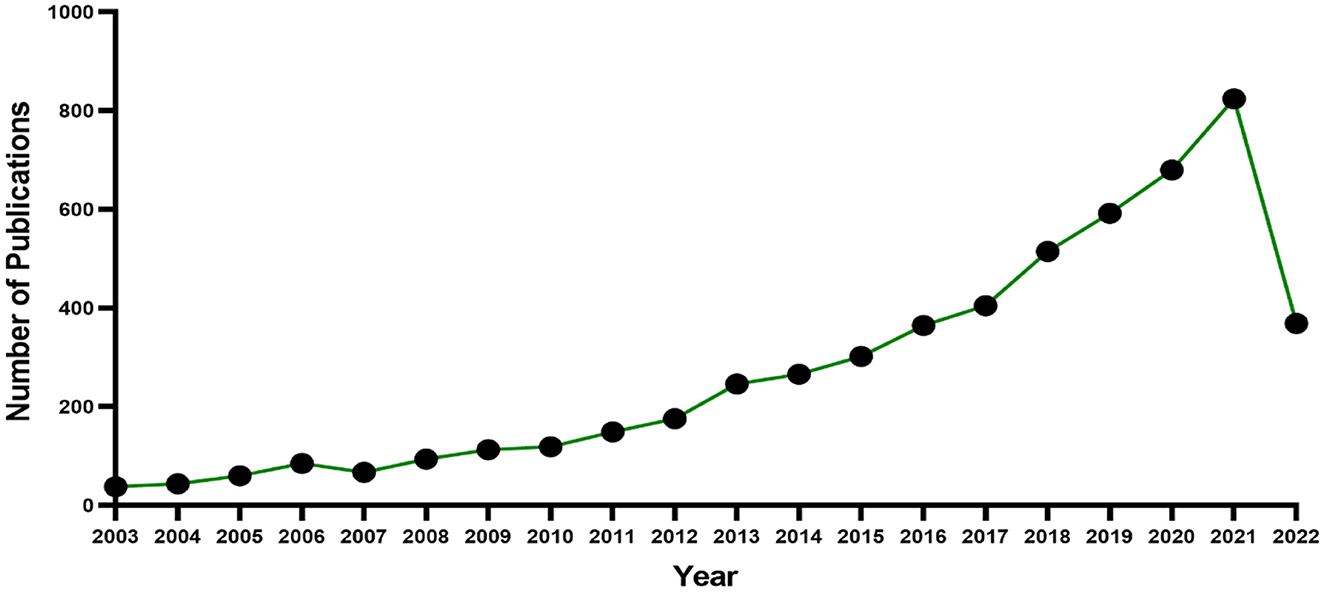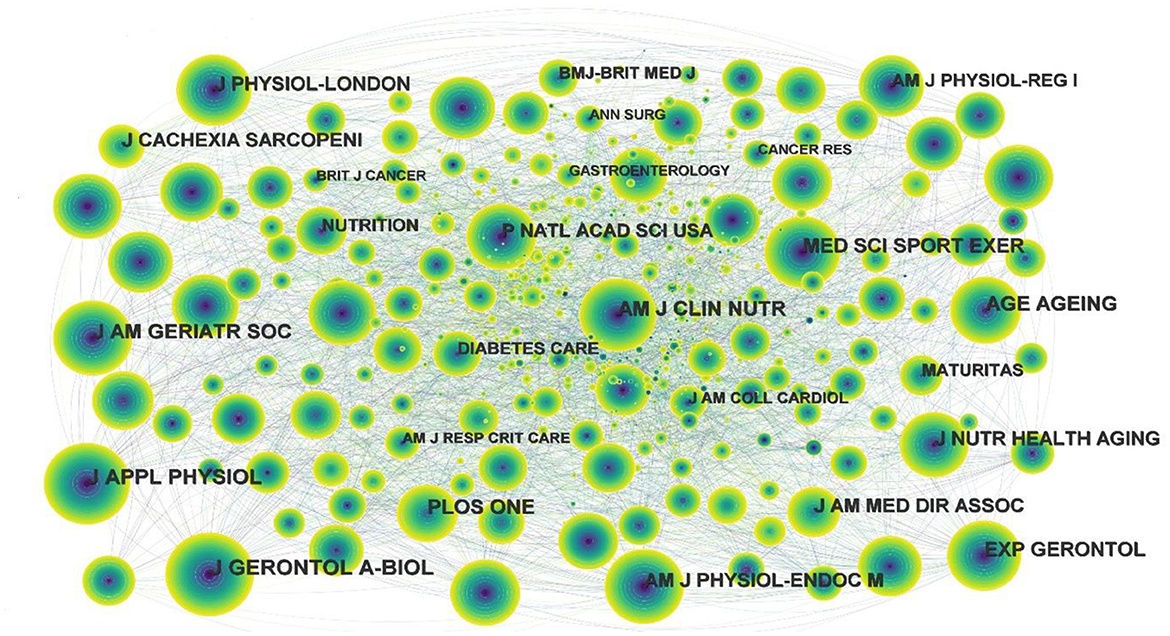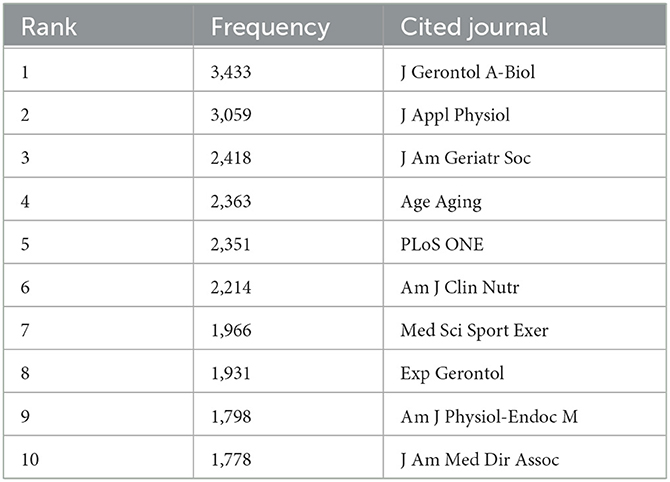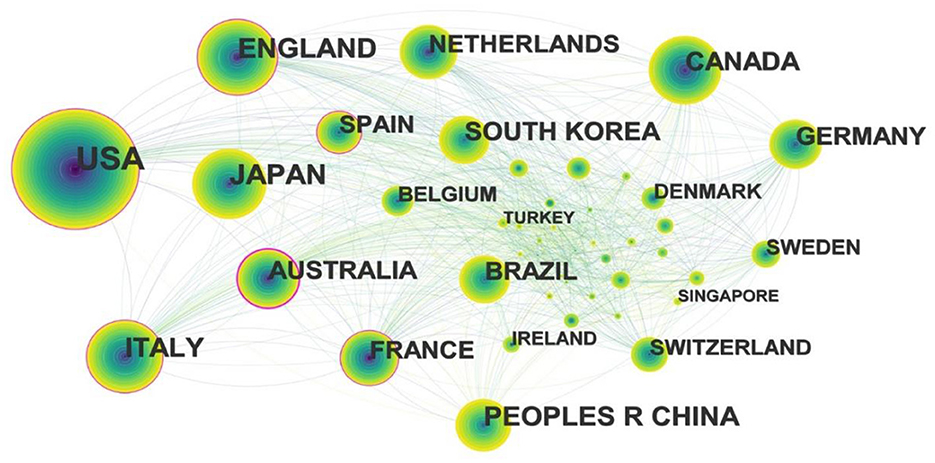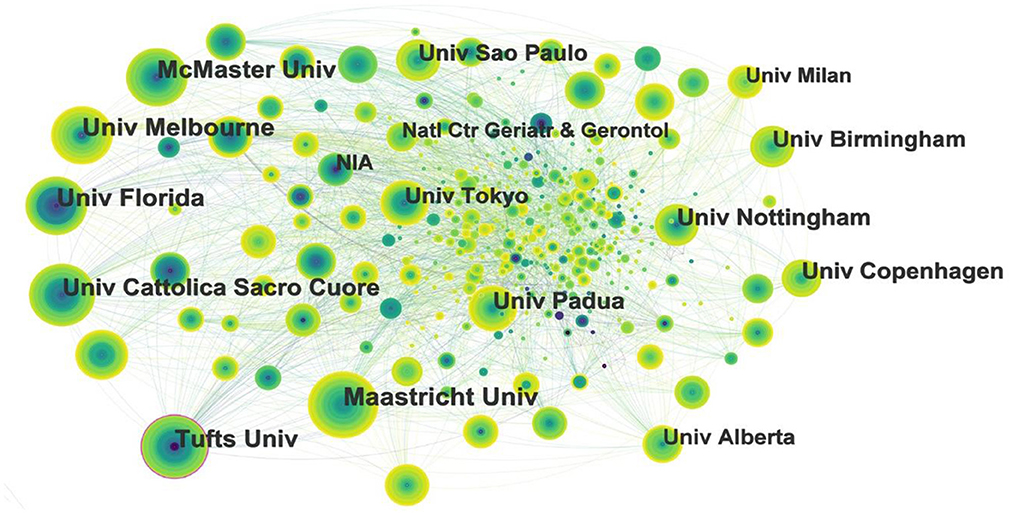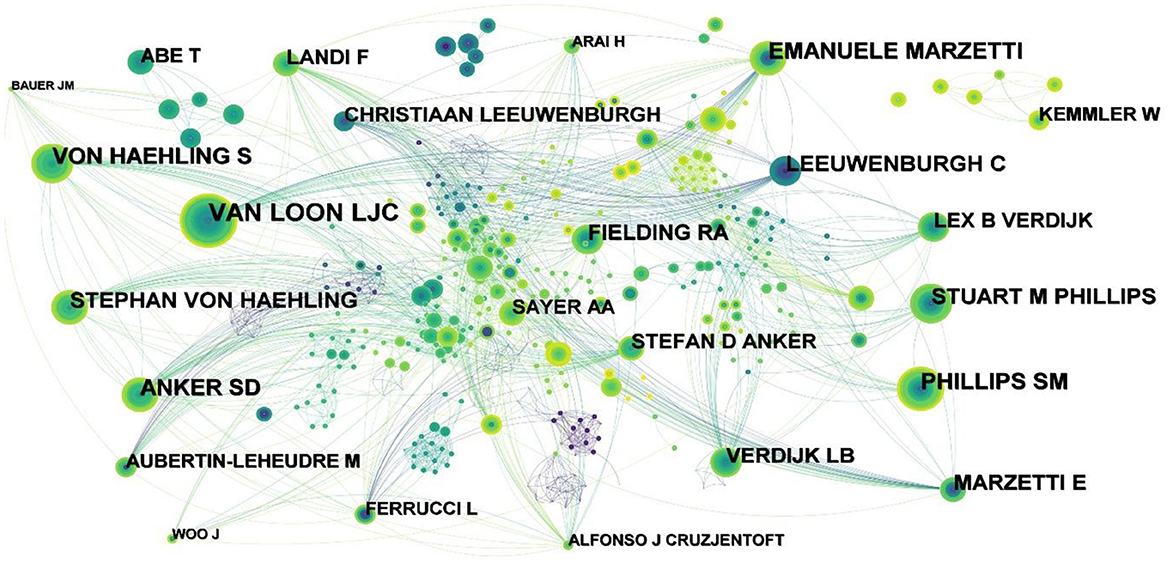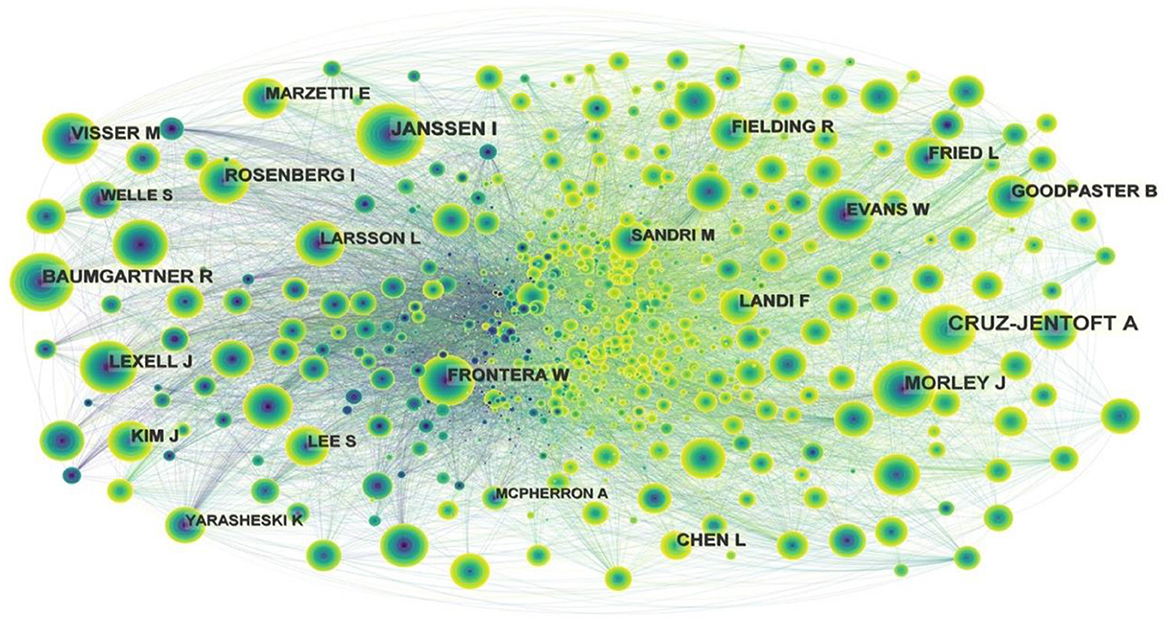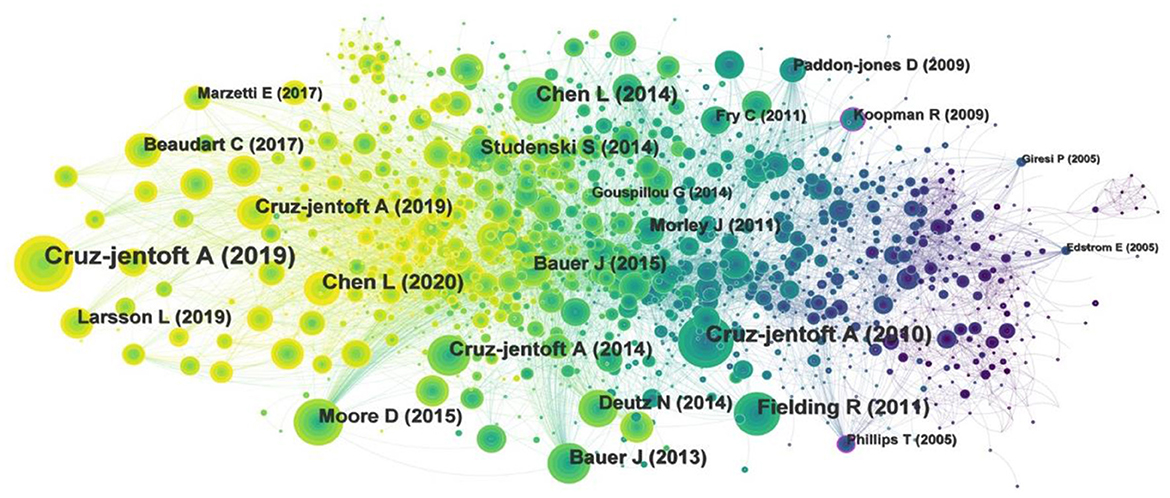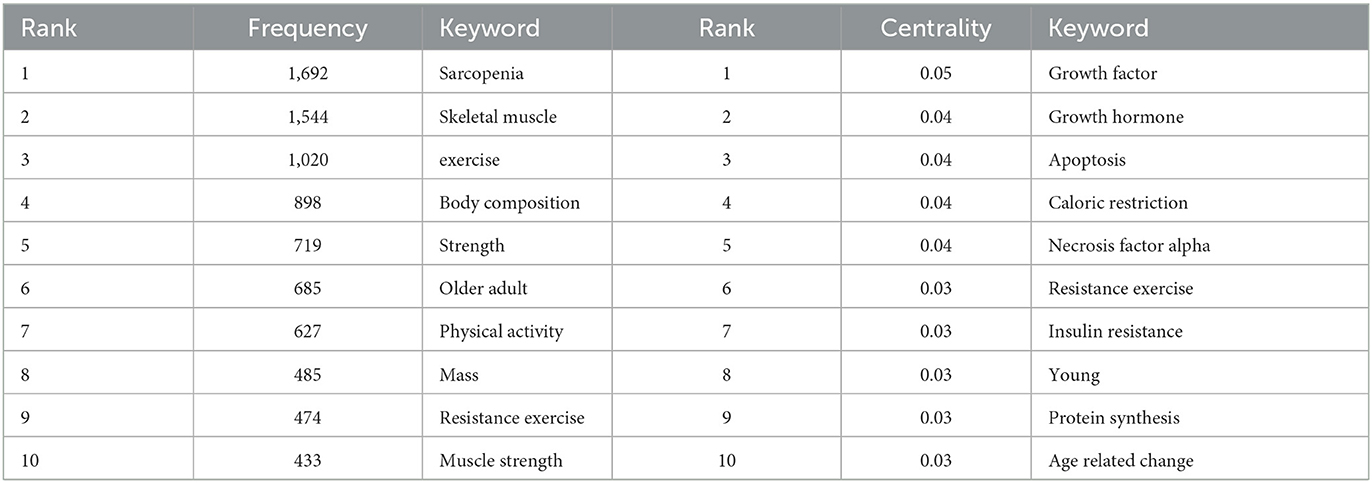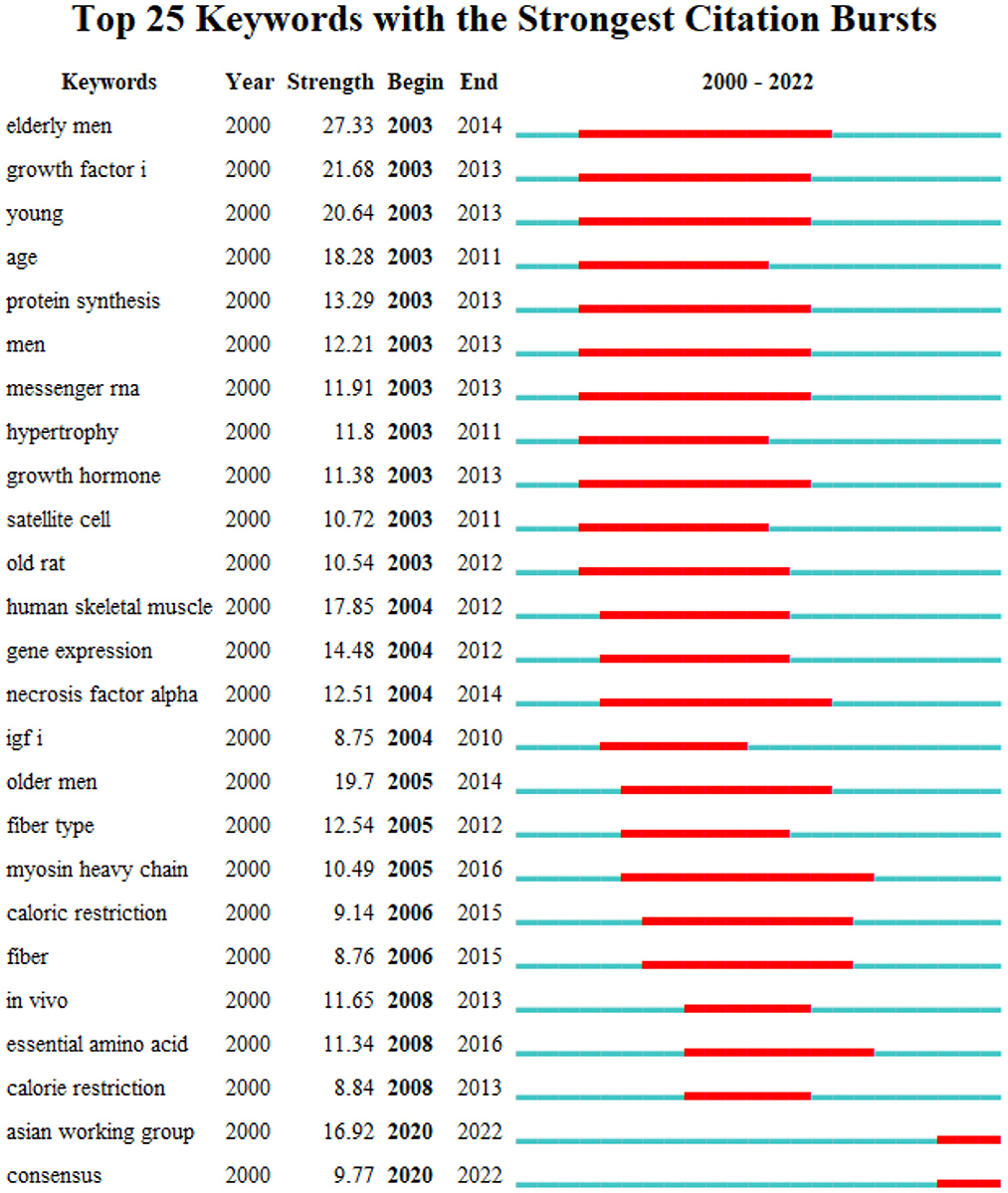- 1Rehabilitation Technology Innovation Center by Joint Collaboration of Ministry of Education and Fujian Province, Fujian University of Traditional Chinese Medicine, Fuzhou, China
- 2College of Rehabilitation Medicine, Fujian University of Traditional Chinese Medicine, Fuzhou, China
Exercise is an effective method for the prevention and treatment of sarcopenia, which can improve skeletal muscle mass, strength and physical function in individuals with sarcopenia to varying degrees. Moreover, exercise has an important role in improving ability to perform daily activities and quality of life on sarcopenia. In this study, articles and review articles on exercise interventions for sarcopenia from January 2003 to July 2022 were retrieved from the Web of Science core collection. Then, the number of annual publications, journal/cited journal, country, institution, author/cited author, references and keywords were analyzed using CiteSpace 6.1.R2. A total of 5,507 publications were collected and the number of publications increasing each year. Experimental Gerontology was the most productive journal and the most cited journal was J GERONTOL A-BIOL. The United States of America was the most influential country with the largest number of publications and centrality. Maastricht University in the Netherlands is the most productive institution. The author VAN LOON LJC has the highest ranking in terms of publications and CRUZ-JENTOFT A is ranked first in terms of cited authors. The most frequently occurring keywords in the field of exercise interventions for sarcopenia are “skeletal muscle,” “exercise,” “body composition,” “strength,” and “older adult”; the keyword “elderly men” showed the strongest explosive intensity. The keywords formed 6 clusters, namely “skeletal muscle,” “muscle strength,” “heart failure,” “muscle protein synthesis,” “insulin resistance” and “high-intensity interval training.” In conclusion, this study demonstrates a new perspective on the current state of research and trends in exercise interventions for sarcopenia over the past 20 years via the visualization software CiteSpace. It may help researchers to identify potential collaborators and partner institutions, hotspots and research frontiers in the field of exercise interventions for sarcopenia.
1. Introduction
Sarcopenia is defined as age-related loss of muscle mass, plus low muscle strength, and/or low physical performance by the Asian Working Group for Sarcopenia (AWGS) (1). With the increasing aging of the global population, sarcopenia has become a common disease in the elderly, which not only increases the risk of falls, disability and death (2), but is also associated with a significantly higher risk of cardiovascular disease (3, 4). Sarcopenia seriously impair the physical health and quality of life of the elderly. Therefore, it is necessary to find and develop low-cost, easily accessible rehabilitation methods for sarcopenia. However, there are no effective therapeutic drugs for sarcopenia (5) and exercise plays an important role in its prevention and treatment. Physical activity is one of the recommendations for the management of sarcopenia, which was given by the International clinical Practice Guidelines for Sarcopenia in 2018 (6). The commonly used exercise methods include resistance exercise, aerobic exercise, combination of resistance and aerobic exercise, balance training, flexibility training and other auxiliary exercise methods. These exercises have a positive effect on increasing muscle mass and strength in patients with sarcopenia. These exercises have a positive effect on increasing muscle mass and strength in people with sarcopenia.
Therefore, it is necessary to conduct a comprehensive summary of the research about exercise interventions for sarcopenia. This study used the visualization software CiteSpace to analyze 5,507 retrieved records from January 2003 to July 2022 related to exercise interventions for sarcopenia. Based on a visual bibliometric analysis of the literature from the perspectives of the number of annual publications, countries, institutions, authors, keywords and citations, show the current status and development trend of exercise interventions for sarcopenia. The purpose of this study is to provide a reference for future research about exercise interventions for sarcopenia.
2. Materials and methods
2.1. Database selection
In this study, the Web of Science (WOS) core collection was selected as the data source. Web of Science, as a high-quality digital literature resource database, has been accepted by many researchers. Furthermore, the Web of Science Core Collection has a rigorous selection process based on law of Bradford and includes only the most important scholarly journals in each subject area. Web of Science core collection is regarded as the most suitable database for bibliometric analysis (7).
2.2. Search strategy
The search strategy we used was entering the search expression: Topic = (sarcopenia) AND Topic = (“exercise” OR “training” OR “sport” OR “movement” OR “motion”) in the Web of Science core collection. The scope of topic search includes the following fields: title, abstracts, author keywords, and keywords plus. At the time of retrieval, the publication date of the literature was unrestricted. The retrieval date was July 24, 2022. The literature type was selected as article and review article, and the language chose English. Finally, we obtained a total of 5,507 publications related to exercise interventions for sarcopenia.
2.3. Data standardization
All bibliometric records of the 5,507 retrieved literature were downloaded as “full records and cited references” from SCIE. Microsoft Excel 2021 (Microsoft Corporation, Redmond, WA, USA) and CiteSpace 6.1.R2 (Drexel University, Philadelphia, PA, USA) were used to standardize, analyze, and visualize the records.
All records need to be standardized before the bibliometric analysis. Above all, CiteSpace was used to remove the potential duplicate records. Since different names may appear for specific authors or institutions and lead to computational errors, we manually screened the names of identified authors and institutions with high publication volumes and merged the information after confirming that it came from the same author or institution.
2.4. Bibliometric analysis
Descriptive analyses of bibliometric indicators, including the annual number of publications, journals, countries, authors and keywords were analyzed in Microsoft Excel 2021.
In this study, CiteSpace was used to draw the knowledge maps, and the co-occurrence network maps of annual publications, journals, countries, institutions, authors, references and keywords were constructed. CiteSpace is a Java-based application, developed by Professor Chaomei Chen, which visualizes interrelationships between scientific articles according to their co-citation patterns (8, 9). The visual knowledge maps display the networks as the commonly seen types of node-and-link diagrams. Nodes in different networks can represent different elements, such as country, author, institution and keyword. The size of the node, which generally indicates the frequency of citation or appearance, and the different colors of the nodes indicate different years. The warmer the color, the more recent the year, and the cooler the color, the more distant the year. Links between nodes indicate collaboration or co-occurrence or co-referencing relationships. The purple ring represents centrality, and nodes with high centrality (>0.1) are usually considered as key points or turning points in a specific domain. The version of the software is constantly updated, and the version used in this study is 6.1.R2 (64-bit).
3. Results
3.1. Analysis of annual publications
There are 5,507 records related to exercise interventions for sarcopenia in the Web of Science core collection. The number of publications displayed by year is shown in Figure 1. From the figure, we can see the literature in this field was first published in 2003, and the number of publications has increased year by year. The number of publications in 2022 is only counted from January to July, but it is predicted that the number of publications in 2022 will also show an upward trend. From 2003 to 2013, the number of publications was small, but the overall trend was on the rise, indicating that the research related to exercise interventions for sarcopenia gradually attracted the attention of researchers during this period. After 2013, the number of publications increased rapidly, indicating that the research in this field has been highly valued by researchers at this stage, and exercise rehabilitation has become the focus of sarcopenia.
3.2. Analysis of journals and cited journals
The top five journals with the largest number of published exercise interventions for sarcopenia studies are listed in Table 1. Among these five journals, Experimental Gerontology, Journals of Gerontology Series A-Biological Sciences and Medical Sciences are geriatrics journals. Journal of Cachexia Sarcopenia and Muscle is a journal named sarcopenia. Nutrients and PLoS ONE are general journals.
Moreover, the cited journal map was generated by CiteSpace (Figure 2), yielding 1,166 nodes and 11,707 links. The nodes in the map represent journals, and links between nodes represent co-citation relationships. As can be seen from the figure, there is no purple ring in these nodes, indicating that the centrality of these cited journals is not high, and ANNSURG with the highest centrality is only 0.05. The top 10 journals related to exercise interventions for sarcopenia are listed in Table 2.
3.3. Analysis of countries
To understand which countries are most prominent in the field of exercise interventions for sarcopenia, we used CiteSpace to generate a country map (Figure 3). The 5,507 records were published in 84 countries, and the top five countries of publications are listed in Table 3. The United States of America was the country with the largest number of publications, accounting for about a third of the articles (1,619). Japan and England ranked second and third, respectively, followed by China and Italy.
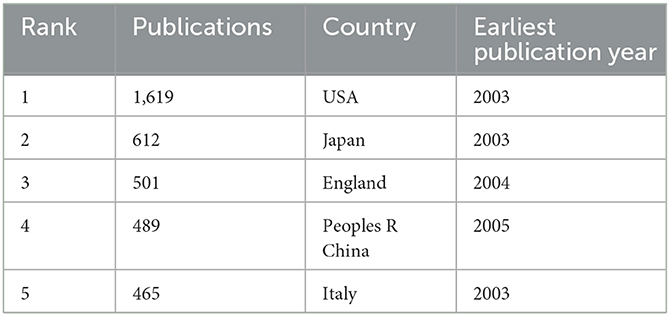
Table 3. Top five countries in the number of publications related to exercise interventions for sarcopenia.
As shown in Figure 3, the nodes represent countries, and the purple rings indicated the centrality of the literature. The top five countries in centrality are Australia (0.27), Spain (0.2), England (0.19), USA (0.17), and France (0.13). The United States of America has an advantage in numbers, while Australia has an advantage in importance. In the following years, exercise interventions for sarcopenia has attracted increasing attention in Asian countries such as China and South Korea.
3.4. Distribution of institutions
Among the 607 institutions with the highest attention in the field of exercise interventions for sarcopenia, the top 5 institutions are all comprehensive universities (Figure 4). They are Maastricht University, University of Florida, University of Melbourne, Tufts University, and McMaster University. The only two universities with centrality >1 were Tufts University (0.12) and the University of Florida (0.1). The number of publications and centrality analysis show that the main research institutions in this field are Tufts University and the University of Florida, which form the core of the complex cooperative network. Tufts previous research focused on sarcopenia diagnosis, nutrition and exercise interventions, body composition, and osteoporosis combined with sarcopenia. In recent years, however, Tufts has shifted its focus to the role of gut microbiota on muscle mass and strength in sarcopenia. The exercise interventions for sarcopenia research at the University of Florida mainly involves the combination with chronic diseases, inflammation, mitochondrial function, oxidative stress and so on.
3.5. Analysis of authors and cited authors
The authors of the 5,507 records were analyzed, and 1,019 nodes and 3,517 links were obtained (Figure 5), indicating that 5,507 articles were published by 1,019 authors. The top five authors were VAN LOON LJC (53), PHILLIPS SM (37), EMANUELE MARZETTI (36), VON HAEHLING S (35), and ANKER SD (34). The research focus of VAN LOON LJC and PHILLIPS SM is similar, mainly focusing on the effects of exercise (10), protein supplementation on muscle protein synthesis (11–15) and muscle strength (16) in sarcopenia. PHILLIPS SM mainly focuses on nutritional supplements in support of resistance exercise to sarcopenia (17–20). EMANUELE MARZETTI not only focused on physical activity and exercise (21), but also analyzed biomarkers of frailty and sarcopenia to provide a reference for the diagnosis and detection of sarcopenia (22–24). VON HAEHLING S focuses on sarcopenia and cachexia caused by heart failure (25–28).
The map of cited authors is shown in Figure 6. CRUZ-JENTOFT A had the highest citation counts (1,878), followed by JANSSEN I, MORLEY J, BAUMGARTNER R, and VISSER M (Table 4). Figure 6 shows that there is no purple ring, indicating that the centrality of cited authors are all < 0.1.
3.6. Analysis of cited references
Figure 7 is the cited reference co-citation map, yielding 1,618 nodes and 8,483 links. The two most frequently cited references are those published by CRUZ-JENTOFT A in 2019 and 2010, respectively (29, 30). These two articles detail the consensus on definition and diagnosis for sarcopenia of the European Working Group on Sarcopenia in Older People (EWGSOP) in 2019 and 2010. The third and fourth cited references detail the consensus on the diagnosis and treatment for sarcopenia of the Asian Working Group for Sarcopenia (AWGS), which was published by Liang-Kung Chen et al. in 2014 and 2020, respectively (1, 31). The fifth cited references was the expert consensus on the definition, prevalence, etiology and outcome for sarcopenia of the International Working Group on Sarcopenia published by Fielding R in 2011 (32). It can be seen that there is no unified definition and diagnostic criteria for sarcopenia at present, furthermore they are constantly updated. Different countries and regions may choose different diagnostic criteria. However, these working groups provide information on the definition, diagnosis and intervention of sarcopenia, which is a valuable reference for researchers engaged in sarcopenia.
The article published by Koopman R in 2009, with a centrality of 0.17, ranked first in cited references, which expounded the relationship between aging, exercise and muscle protein metabolism (33). This article pointed out that aging is accompanied by a steady loss of skeletal muscle mass and strength, age-related skeletal muscle mass loss due to interruptions of skeletal muscle protein turnover adjust to imbalances between muscle protein synthesis and degradation.
We also performed cluster analysis on the cited references to clarify the topic and time distribution of these cited references (Figure 8). In this clustering map, the Q value is 0.6939 and S value is 0.8654, indicating than the clustering effect is valid and the credibility is high. A color region in the clustering map represents a topic. As can be seen from the color in the map, the topics of cited references focus on “resistance training,” “apoptosis, mitochondria,” “skeletal muscle,” “protein,” “amino acid,” “heart failure,” “cirrhosis,” “proteomics,” “monoclonal antibody,” and “machine learning.”
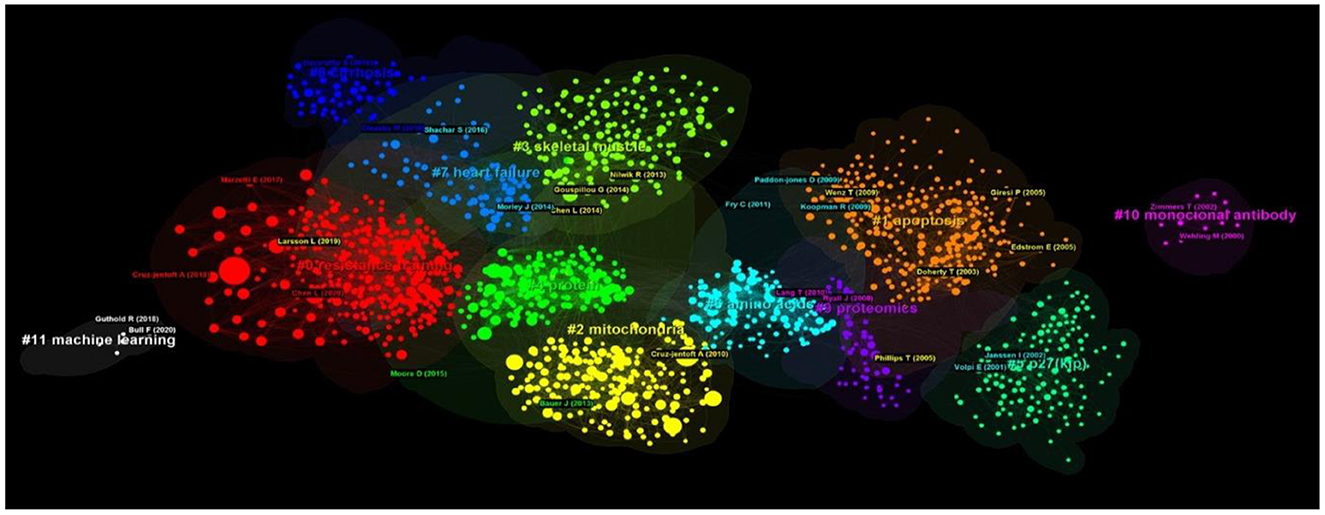
Figure 8. The clustering map of cited references related to exercise interventions for sarcopenia from 2003 to 2022.
3.7. Analysis of keywords
It was considered that the increased frequency of keywords can reflect hot topics, and burst keywords which are cited frequently over a period of time could indicate frontier topics. We generated the network map of keywords, yielding 768 nodes and 9,176 links (Figure 9). A total of 768 research keywords were identified in the field of exercise interventions for sarcopenia, which reveals the hottest topics. According to the frequency and centrality of keywords (Table 5), it can be seen that the hot keywords are “sarcopenia,” “skeletal muscle,” “exercise,” “body composition,” “strength,” “older adult,” “physical activity,” “mass” and “resistance exercise,” while “resistance exercise” has a high frequency and centrality. The strength and mass of skeletal muscle are the focus of attention in sarcopenia. Therefore, the ultimate goal of any intervention is to improve the strength and mass of skeletal muscle, in order to improve the physical function of sarcopenia. Exercise is the most commonly used, easy to achieve, and effective method of sarcopenia rehabilitation. Resistance exercise is the most commonly used in the clinic, which has a significant effect on increasing the mass and strength of skeletal muscle.
The top 25 keywords with the strongest burst were obtained by time series burst detection of highly cited keywords (Figure 10). Among these keywords, “elderly men,” “young,” “age,” “men,” “old rat” are subjects of exercise rehabilitation studies for sarcopenia, “growth factors,” “protein synthesis,” “messenger rna,” “hypertrophy,” “growth hormone,” “satellite cell,” “necrosis factor alpha,” “necrosis factor alpha,” “igf i,” “myosin heavy chain,” “caloric restriction,” “essential amino acid” are the key research directions. The keyword “elderly men,” which emerged since 2003, showed the strongest citation burst of 27.33. The second most hot word was “growth factor” with strength of 21.68.
The most recent burst keywords were “Asian working group” and “consensus.” “Asian working group” means the Asian Working Group for Sarcopenia. In 2019, the Asian Working Group for Sarcopenia released the latest expert consensus on the diagnosis and treatment of sarcopenia (1), the highlight of which is that medical institutions at different levels should adopt different diagnostic strategies. The expert consensus also give detailed diagnosis and treatment methods for sarcopenia. At the same time, the diagnostic threshold is also updated, which is more operable.
Cluster analysis and summary of these keywords can provide a more intuitive understanding of the current Research Topics related to exercise rehabilitation of sarcopenia (Figure 11). After clustering, the Q-value is 0.3397 and the S-value is 0.669, indicating that clustering is appropriate and meaningful. A total of six clusters were generated to reflect the hot trends, and they are “skeletal muscle,” “muscle strength,” “heart failure,” “muscle protein synthesis,” “insulin resistance” and “high-intensity interval training.” From the timeline view (Figure 12), “insulin resistance” and “high-intensity interval training” are the latest studies, while “skeletal muscle” and “muscle strength” appear earlier.
4. Discussion
4.1. General knowledge structure in exercise interventions for sarcopenia research
Exercise is a significant rehabilitation method for sarcopenia, which has received wide attention and is the key research direction of sarcopenia. Exercise rehabilitation has the advantages of easy operation and personalized exercise prescription. In this study, 5,507 records on exercise interventions for sarcopenia from January 2003 to July 2022 were retrieved from the Web of Science core collection. Based on the bibliometrics analysis of CiteSpace, we have clarified the spatial and temporal distribution and research hotspots of exercise interventions for sarcopenia. In the past 20 years, publications related to exercise interventions for sarcopenia have grown rapidly. In this study, the Journal of Experimental Gerontology published the most articles (225), and J GERONTOL A-BIOL was the biggest cited (3,433). The countries and institutions that carry out exercise interventions for sarcopenia research had relatively close cooperation. Generally, the United States of America, Australia, and some other European countries, with a high publication rate and centrality, all developed countries, were leading the field of exercise interventions for sarcopenia. The most productive institution was Maastricht University in the Netherlands. A total of 1,019 authors from different countries conducted studies on exercise interventions for sarcopenia. Of these authors, VAN LOON LJC was the most productive author, while CRUZ-JENTOFT A ranked first among cited authors. The cited reference with the highest centrality was a review, which focuses on the relationship between aging, exercise and muscle protein metabolism, published by Koopman R in 2009. Cluster analysis of the cited literature show that the most recently cited hot topics, respectively, were “resistance training,” “apoptosis, mitochondria,” “skeletal muscle,” “protein,” “amino acid,” “heart failure,” “cirrhosis,” “proteomics,” “monoclonal antibody,” and “machine learning.”
The hot keywords in the field of exercise interventions for sarcopenia are “sarcopenia,” “skeletal muscle,” “exercise,” “body composition,” “strength,” “older adult,” “physical activity,” “mass,” and “resistance exercise.” The keyword “elderly men” showed the strongest citation burst, and the second outbreak word was “growth factor.” A total of six clusters were formed, which, respectively, were “skeletal muscle,” “muscle strength,” “heart failure,” “muscle protein synthesis,” “insulin resistance” and “high-intensity interval training.” The keywords of “growth factors,” “protein synthesis,” “messenger rna,” “hypertrophy,” “growth hormone,” “satellite cell,” necrosis factor alpha,” “necrosis factor alpha,” “igf i,” “myosin heavy chain,” “caloric restriction,” “essential amino acid,” suggest the mechanisms or targets of exercise interventions for sarcopenia.
4.2. Main types of exercise for sarcopenia rehabilitation
Exercise therapy is an effective method to prevent and treat sarcopenia (34–39). The commonly used exercise methods include resistance exercise, aerobic exercise, combination of resistance and aerobic exercise, and other auxiliary exercise methods. The keyword related-information in this study shows that resistance exercise is the most commonly used.
4.2.1. Resistance exercise
Resistance exercise as an effective way to enhance skeletal muscle protein synthesis, stimulate muscle hypertrophy and improve muscle strength, is the best-recommended exercise for sarcopenia (40–44). The resistance overcome during resistance exercise can be constant or incremental, which can be chosen according to the actual situation of the individuals. The types of exercises include weight lifting, seated leg lifts, static squats against the wall, stretching elastic bands, etc. For individuals with severe sarcopenia, rehabilitation equipment is often used to assist in training. The most recommended rehabilitation program for elderly participants with sarcopenia is at least 8 weeks, 3–4 times per week, actions at intensities of 40–60% of 1-repetition maximum, and for the untrained elderly, the exercise dose can be reduced to 2–3 times per week (45).
4.2.2. Aerobic exercise
Although aerobic exercise cannot stimulate muscle hypertrophy, it can enhance muscle endurance level and muscle contraction capacity by effectively inhibiting the expression of apoptotic factors, improving cell mitochondrial quality and enhancing the activity of metabolic enzymes, thus maintaining muscle function and improving cardiorespiratory endurance (46). Aerobic exercise for about 30 min a day, 3 times a week, for more than 5 months can significantly improve the symptoms and prognosis of sarcopenia (37). Common aerobic exercises include walking, brisk walking, jogging, cycling, swimming, dancing, tai chi, setting-up exercise and some small-ball sports, etc. Participants can choose according to their own situation and interest. Aerobic exercise should start with low-intensity exercise (40% of maximum heart rate), lasting 5–10 min per day; medium intensity (50–60% of maximum heart rate), at least 10 min per time, 5 days per week; high intensity (>60% of maximum heart rate), at least 20–30 min per time, at least 3 days per week (47).
4.2.3. Combination of resistance and aerobic exercise
Resistance exercise can significantly increase muscle mass and strength, but the effect of improving cardiopulmonary endurance is not significant. Aerobic exercise can effectively improve cardiopulmonary endurance, but the improvement of muscle function is limited. Furthermore, the single exercise mode is easy to produce muscle fatigue, lack of fun, and it is difficult for participants to adhere for a long time. Therefore, multi-component exercise is often used clinically to intervene in participants with sarcopenia, such as moderate resistance training, aerobic + resistance training, resistance + balance + gait training and resistance training + outdoor activities, etc. The multi-exercise approach is not only effective, but also more stimulating to participants' interest in exercise (44, 48).
4.2.4. Other auxiliary exercise
Participants with sarcopenia have a gradual loss of balance ability and postural control disorders, which become important factors leading to fall and poor physical flexibility (49, 50). Therefore, it is recommended that older adults perform balance training, such as cross-pacing and tai chi (51), more than three times a week as a way to reduce the risk of falls. At the same time, a cumulative total of at least 2 weeks of flexibility training should be conducted each month, with a moderate to light dose of 10 min each time, including the neck, shoulders, kinesiology, knees and other joint parts (52). For elderly people who are constrained by physical conditions or unwilling to carry out dynamic exercise training, whole body vibration therapy can be used to stimulate the muscles, which can also achieve desired results (53–55). In addition, participants with sarcopenia should try to reduce sedentary and bed-ridden in daily life, and should increase the frequency of daily activities, such as gardening, traveling, housework, shopping, climbing stairs, etc., which can play a role in exercising limb strength.
In this study, six clusters were obtained after cluster analysis of keywords. One of the keywords was high-intensity interval training (HIIT), which has attracted much attention in recent years. Multimodal HIIT has a combination of aerobic and anaerobic performance effects, and has significant effects on improving muscle strength and muscle endurance. HIIT also produce beneficial effects on cardiorespiratory fitness, physical fitness, muscle strength, cardiac contractile function, mitochondrial citrate synthase activity, and lowering blood triglyceride and glucose levels in older adults (56). However, it is worth mentioning that HIIT, as a high-intensity exercise mode, should only be performed by participants with sarcopenia after a systematic physical assessment to determine the appropriate exercise dose. Currently, there are no studies directly targeting participants with sarcopenia for high-intensity interval training due to safety reasons (57).
In addition, the results of several studies confirm that exercise combined with nutritional supplementation is the best choice for the rehabilitation of sarcopenia. Supplementation with protein, amino acids, vitamin D and other nutrients along with exercise intervention can promote muscle protein synthesis, muscle cell proliferation and differentiation, significantly delaying muscle aging (19, 58–61).
4.3. Future trends
Timeline view analysis and burst detection methods were used to identify cutting-edge content and reveal future trends. From Figure 12, we found that heart failure, muscle protein synthesis, insulin resistance, and high-intensity interval training are the hot spots of research in recent years. With the emergence of diversified exercises and their good results in the rehabilitation of sarcopenia, researchers are increasingly concerned about the mechanism of action and safety of exercise for sarcopenia. Sarcopenia was a common condition in participants with heart failure, and heart failure can induce sarcopenia. Therefore, early detection of sarcopenia and appropriate interventions are important in heart failure (62–64). The aim of exercise interventions for sarcopenia is to improve muscle mass and strength. The analysis of timeline view revealed that protein synthesis and insulin resistance are closely related to muscle mass and strength, which provides a direction to study the mechanism of exercise interventions for sarcopenia.
4.4. Strengths and limitations
This study summarized the hotspots and research trends of exercise for sarcopenia, and provided a meaningful reference for the research in this field. However, this study also has some limitations. Firstly, we only analyzed data from the Web of Science core collection. Searches are not selected in PubMed, Scopus, or other databases. Second, the literature contains papers in English only; the status of research on exercise interventions for sarcopenia in other language nations is not possible to determine. Lastly, the number of citations and centrality of articles may vary if the search is conducted at different time periods. Therefore, this study only represents the hotspots in the last 20 years.
5. Conclusion
This study uses the visualization software CiteSpace to identify potential collaborators and partner institutions, hot topics and new perspectives on research frontiers in the research of exercise interventions for sarcopenia. Bibliometric analysis of the literature shows that exercise, as the most significant intervention, remains the most cutting-edge and critical component in the rehabilitation of sarcopenia. Looking for scientific, effective and safe exercise prescriptions will be the focus of future research. In conclusion, our study provided a comprehensive landscape of the development and identified the key features of exercise interventions for sarcopenia over the past 20 years. This may provide a direction for the exploration and development of exercise interventions for sarcopenia.
Author contributions
QX contributed to conception and design of the study and obtaining funding for the study, and wrote the first draft of the manuscript. YH and JZ contributed to data collection and analysis. WL and JT contributed to manuscript revision. All authors contributed to manuscript revision, read, and approved the submitted version.
Funding
This work was supported by the project of Rehabilitation Technology Innovation Center by Joint Collaboration of Ministry of Education and Fujian Province grant number X2022003-Collaboration, school management project of Fujian University of Traditional Chinese Medicine grant number X2020017, and basic science research promotion project of Fujian University of Traditional Chinese Medicine grant number XJC2022005.
Conflict of interest
The authors declare that the research was conducted in the absence of any commercial or financial relationships that could be construed as a potential conflict of interest.
Publisher's note
All claims expressed in this article are solely those of the authors and do not necessarily represent those of their affiliated organizations, or those of the publisher, the editors and the reviewers. Any product that may be evaluated in this article, or claim that may be made by its manufacturer, is not guaranteed or endorsed by the publisher.
References
1. Chen LK, Woo J, Assantachai P, Auyeung TW, Chou MY, Iijima K, et al. Asian working group for sarcopenia: 2019 consensus update on sarcopenia diagnosis and treatment. J Am Med Dir Assoc. (2020) 21:300–7. doi: 10.1016/j.jamda.2019.12.012
2. Cruz-Jentoft AJ, Sayer AA. Sarcopenia. Lancet. (2019) 393:2636–46. doi: 10.1016/S0140-6736(19)31138-9
3. Gao K, Cao LF, Ma WZ, Gao YJ, Luo MS, Zhu J, et al. Association between sarcopenia and cardiovascular disease among middle-aged and older adults: Findings from the China health and retirement longitudinal study. EClinicalMedicine. (2022) 44:101264. doi: 10.1016/j.eclinm.2021.101264
4. Sasaki KI, Fukumoto Y. Sarcopenia as a comorbidity of cardiovascular disease. J Cardiol. (2022) 79:596–604. doi: 10.1016/j.jjcc.2021.10.013
5. Hardee JP, Lynch GS. Current pharmacotherapies for sarcopenia. Expert Opin Pharmacother. (2019) 20:1645–57. doi: 10.1080/14656566.2019.1622093
6. Dent E, Morley JE, Cruz-Jentoft AJ, Arai H, Kritchevsky SB, Guralnik J, et al. International Clinical Practice Guidelines for Sarcopenia (ICFSR): screening, diagnosis and management. J Nutr Health Aging. (2018) 22:1148–61. doi: 10.1007/s12603-018-1139-9
7. AlRyalat S, Malkawi LW, Momani SM. Comparing bibliometric analysis using PubMed, scopus, and web of science databases. J Vis Exp. (2019) 152:e58494. doi: 10.3791/58494
9. Synnestvedt MB, Chen C, Holmes JH. CiteSpace II: visualization and knowledge discovery in bibliographic databases. AMIA Annu Symp Proc. (2005) 724–8.
10. Shad BJ, Wallis G, van Loon LJ, Thompson JL. Exercise prescription for the older population: the interactions between physical activity, sedentary time, and adequate nutrition in maintaining musculoskeletal health. Maturitas. (2016) 93:78–82. doi: 10.1016/j.maturitas.2016.05.016
11. Snijders T, Verdijk LB, van Loon LJ. The impact of sarcopenia and exercise training on skeletal muscle satellite cells. Ageing Res Rev. (2009) 8:328–38. doi: 10.1016/j.arr.2009.05.003
12. Devries MC, Phillips SM. Supplemental protein in support of muscle mass and health: advantage whey. J Food Sci. (2015) 80(Suppl. 1):A8–15. doi: 10.1111/1750-3841.12802
13. Fuchs CJ, Hermans W, Holwerda AM, Smeets J, Senden JM, van Kranenburg J, et al. Branched-chain amino acid and branched-chain ketoacid ingestion increases muscle protein synthesis rates in vivo in older adults: a double-blind, randomized trial. Am J Clin Nutr. (2019) 110:862–72. doi: 10.1093/ajcn/nqz120
14. Holwerda AM, Paulussen K, Overkamp M, Goessens J, Kramer IF, Wodzig W, et al. Dose-dependent increases in whole-body net protein balance and dietary protein-derived amino acid incorporation into myofibrillar protein during recovery from resistance exercise in older men. J Nutr. (2019) 149:221–30. doi: 10.1093/jn/nxy263
15. Nunes EA, Colenso-Semple L, McKellar SR, Yau T, Ali MU, Fitzpatrick-Lewis D, et al. Systematic review and meta-analysis of protein intake to support muscle mass and function in healthy adults. J Cachexia Sarcopenia Muscle. (2022) 13:795–810. doi: 10.1002/jcsm.12922
16. Tieland M, Franssen R, Dullemeijer C, van Dronkelaar C, Kyung KH, Ispoglou T, et al. The impact of dietary protein or amino acid supplementation on muscle mass and strength in elderly people: individual participant data and meta-analysis of RCT's. J Nutr Health Aging. (2017) 21:994–1001. doi: 10.1007/s12603-017-0896-1
17. Devries MC, Phillips SM. Creatine supplementation during resistance training in older adults-a meta-analysis. Med Sci Sports Exerc. (2014) 46:1194–203. doi: 10.1249/MSS.0000000000000220
18. Phillips SM. Nutritional supplements in support of resistance exercise to counter age-related sarcopenia. Adv Nutr. (2015) 6:452–60. doi: 10.3945/an.115.008367
19. McKendry J, Currier BS, Lim C, Mcleod JC, Thomas A, Phillips SM. Nutritional supplements to support resistance exercise in countering the sarcopenia of aging. Nutrients. (2020) 12:2057. doi: 10.3390/nu12072057
20. McKendry J, Stokes T, Mcleod JC, Phillips SM. Resistance exercise, aging, disuse, and muscle protein metabolism. Compr Physiol. (2021) 11:2249–78. doi: 10.1002/cphy.c200029
21. Marzetti E, Calvani R, Tosato M, Cesari M, Di Bari M, Cherubini A, et al. Physical activity and exercise as countermeasures to physical frailty and sarcopenia. Aging Clin Exp Res. (2017) 29:35–42. doi: 10.1007/s40520-016-0705-4
22. Tosato M, Marzetti E, Cesari M, Savera G, Miller RR, Bernabei R, et al. Measurement of muscle mass in sarcopenia: from imaging to biochemical markers. Aging Clin Exp Res. (2017) 29:19–27. doi: 10.1007/s40520-016-0717-0
23. Calvani R, Picca A, Marini F, Biancolillo A, Gervasoni J, Persichilli S, et al. Identification of biomarkers for physical frailty and sarcopenia through a new multi-marker approach: results from the BIOSPHERE study. Geroscience. (2021) 43:727–40. doi: 10.1007/s11357-020-00197-x
24. Picca A, Coelho-Junior HJ, Calvani R, Marzetti E, Vetrano DL. Biomarkers shared by frailty and sarcopenia in older adults: a systematic review and meta-analysis. Ageing Res Rev. (2022) 73:101530. doi: 10.1016/j.arr.2021.101530
25. von Haehling S. The wasting continuum in heart failure: from sarcopenia to cachexia. Proc Nutr Soc. (2015) 74:367–77. doi: 10.1017/S0029665115002438
26. von Haehling S, Ebner N, Dos SM, Springer J, Anker SD. Muscle wasting and cachexia in heart failure: mechanisms and therapies. Nat Rev Cardiol. (2017) 14:323–41. doi: 10.1038/nrcardio.2017.51
27. Saitoh M, Ebner N, von Haehling S, Anker SD, Springer J. Therapeutic considerations of sarcopenia in heart failure patients. Expert Rev Cardiovasc Ther. (2018) 16:133–42. doi: 10.1080/14779072.2018.1424542
28. von Haehling S. Muscle wasting and sarcopenia in heart failure: a brief overview of the current literature. ESC Heart Fail. (2018) 5:1074–82. doi: 10.1002/ehf2.12388
29. Cruz-Jentoft AJ, Baeyens JP, Bauer JM, Boirie Y, Cederholm T, Landi F, et al. Sarcopenia: European consensus on definition and diagnosis: report of the European Working Group on Sarcopenia in Older People. Age Ageing. (2010) 39:412–23. doi: 10.1093/ageing/afq034
30. Cruz-Jentoft AJ, Bahat G, Bauer J, Boirie Y, Bruyere O, Cederholm T, et al. Sarcopenia: revised European consensus on definition and diagnosis. Age Ageing. (2019) 48:16–31. doi: 10.1093/ageing/afy169
31. Chen LK, Liu LK, Woo J, Assantachai P, Auyeung TW, Bahyah KS, et al. Sarcopenia in Asia: consensus report of the Asian Working Group for Sarcopenia. J Am Med Dir Assoc. (2014) 15:95–101. doi: 10.1016/j.jamda.2013.11.025
32. Fielding RA, Vellas B, Evans WJ, Bhasin S, Morley JE, Newman AB, et al. Sarcopenia: an undiagnosed condition in older adults. Current consensus definition: prevalence, etiology, and consequences. International working group on sarcopenia. J Am Med Dir Assoc. (2011) 12:249–56. doi: 10.1016/j.jamda.2011.01.003
33. Koopman R, van Loon LJ. Aging, exercise, and muscle protein metabolism. J Appl Physiol. (2009) 106:2040–8. doi: 10.1152/japplphysiol.91551.2008
34. Phu S, Boersma D, Duque G. Exercise and sarcopenia. J Clin Densitom. (2015) 18:488–92. doi: 10.1016/j.jocd.2015.04.011
35. Beckwee D, Delaere A, Aelbrecht S, Baert V, Beaudart C, Bruyere O, et al. Exercise interventions for the prevention and treatment of sarcopenia. A systematic umbrella review. J Nutr Health Aging. (2019) 23:494–502. doi: 10.1007/s12603-019-1196-8
36. de Mello R, Dalla CR, Gioscia J, Moriguchi EH. Effects of physical exercise programs on sarcopenia management, dynapenia, and physical performance in the elderly: a systematic review of randomized clinical trials. J Aging Res. (2019) 2019:1959486. doi: 10.1155/2019/1959486
37. Nascimento CM, Ingles M, Salvador-Pascual A, Cominetti MR, Gomez-Cabrera MC, Vina J. Sarcopenia, frailty and their prevention by exercise. Free Radic Biol Med. (2019) 132:42–9. doi: 10.1016/j.freeradbiomed.2018.08.035
38. Moore SA, Hrisos N, Errington L, Rochester L, Rodgers H, Witham M, et al. Exercise as a treatment for sarcopenia: an umbrella review of systematic review evidence. Physiotherapy. (2020) 107:189–201. doi: 10.1016/j.physio.2019.08.005
39. Tsekoura M, Billis E, Kastrinis A, Katsoulaki M, Fousekis K, Tsepis E, et al. The effects of exercise in patients with sarcopenia. Adv Exp Med Biol. (2021) 1337:281–90. doi: 10.1007/978-3-030-78771-4_31
40. Giallauria F, Cittadini A, Smart NA, Vigorito C. Resistance training and sarcopenia. Monaldi Arch Chest Dis. (2016) 84:738. doi: 10.4081/monaldi.2015.738
41. Chen N, He X, Feng Y, Ainsworth BE, Liu Y. Effects of resistance training in healthy older people with sarcopenia: a systematic review and meta-analysis of randomized controlled trials. Eur Rev Aging Phys Act. (2021) 18:23. doi: 10.1186/s11556-021-00277-7
42. Cannataro R, Cione E, Bonilla DA, Cerullo G, Angelini F, D'Antona G. Strength training in elderly: An useful tool against sarcopenia. Front Sports Act Living. (2022) 4:950949. doi: 10.3389/fspor.2022.950949
43. Mende E, Moeinnia N, Schaller N, Weiss M, Haller B, et al. Progressive machine-based resistance training for prevention and treatment of sarcopenia in the oldest old: a systematic review and meta-analysis. Exp Gerontol. (2022) 163:111767. doi: 10.1016/j.exger.2022.111767
44. Wang H, Huang WY, Zhao Y. Efficacy of exercise on muscle function and physical performance in older adults with sarcopenia: an updated systematic review and meta-analysis. Int J Environ Res Public Health. (2022) 19:8212. doi: 10.3390/ijerph19138212
45. Silva NL, Oliveira RB, Fleck SJ, Leon AC, Farinatti P. Influence of strength training variables on strength gains in adults over 55 years-old: a meta-analysis of dose-response relationships. J Sci Med Sport. (2014) 17:337–44. doi: 10.1016/j.jsams.2013.05.009
46. Ziaaldini MM, Marzetti E, Picca A, Murlasits Z. Biochemical pathways of sarcopenia and their modulation by physical exercise: a narrative review. Front Med. (2017) 4:167. doi: 10.3389/fmed.2017.00167
47. Chodzko-Zajko WJ, Proctor DN, Fiatarone SM, Minson CT, Nigg CR, Salem GJ, et al. American College of Sports Medicine position stand. Exercise and physical activity for older adults. Med Sci Sports Exerc. (2009) 41:1510–30. doi: 10.1249/MSS.0b013e3181a0c95c
48. Negm AM, Lee J, Hamidian R, Jones CA, Khadaroo RG. Management of sarcopenia: a network meta-analysis of randomized controlled trials. J Am Med Dir Assoc. (2022) 23:707–14. doi: 10.1016/j.jamda.2022.01.057
49. Cawthon PM. Assessment of lean mass and physical performance in sarcopenia. J Clin Densitom. (2015) 18:467–71. doi: 10.1016/j.jocd.2015.05.063
50. Meng NH, Li CI, Liu CS, Lin WY, Lin CH, Chang CK, et al. Sarcopenia defined by combining height- and weight-adjusted skeletal muscle indices is closely associated with poor physical performance. J Aging Phys Act. (2015) 23:597–606. doi: 10.1123/japa.2014-0036
51. Huang CY, Mayer PK, Wu MY, Liu DH, Wu PC, Yen HR. The effect of Tai Chi in elderly individuals with sarcopenia and frailty: a systematic review and meta-analysis of randomized controlled trials. Ageing Res Rev. (2022) 82:101747. doi: 10.1016/j.arr.2022.101747
52. Nelson ME, Rejeski WJ, Blair SN, Duncan PW, Judge JO, King AC, et al. Physical activity and public health in older adults: recommendation from the American College of Sports Medicine and the American Heart Association. Med Sci Sports Exerc. (2007) 39:1435–45. doi: 10.1249/mss.0b013e3180616aa2
53. Wei N, Pang MY, Ng SS, Ng GY. Optimal frequency/time combination of whole body vibration training for developing physical performance of people with sarcopenia: a randomized controlled trial. Clin Rehabil. (2017) 31:1313–21. doi: 10.1177/0269215517698835
54. Chang SF, Lin PC, Yang RS, Yang RJ. The preliminary effect of whole-body vibration intervention on improving the skeletal muscle mass index, physical fitness, and quality of life among older people with sarcopenia. BMC Geriatr. (2018) 18:17. doi: 10.1186/s12877-018-0712-8
55. Wu S, Ning HT, Xiao SM, Hu MY, Wu XY, Deng HW, et al. Effects of vibration therapy on muscle mass, muscle strength and physical function in older adults with sarcopenia: a systematic review and meta-analysis. Eur Rev Aging Phys Act. (2020) 17:14 doi: 10.1186/s11556-020-00247-5
56. Wu ZJ, Wang ZY, Gao HE, Zhou XF, Li FH. Impact of high-intensity interval training on cardiorespiratory fitness, body composition, physical fitness, and metabolic parameters in older adults: a meta-analysis of randomized controlled trials. Exp Gerontol. (2021) 150:111345. doi: 10.1016/j.exger.2021.111345
57. Liu QQ, Xie WQ, Luo YX, Li YD, Huang WH, Wu YX, et al. High intensity interval training: a potential method for treating sarcopenia. Clin Interv Aging. (2022) 17:857–72. doi: 10.2147/CIA.S366245
58. Zhu LY, Chan R, Kwok T, Cheng KC, Ha A, Woo J. Effects of exercise and nutrition supplementation in community-dwelling older Chinese people with sarcopenia: a randomized controlled trial. Age Ageing. (2019) 48:220–8. doi: 10.1093/ageing/afy179
59. Banerjee A, Marotta F, Sriramulu S, Chabria Y, Hari S, Catanzaro R, et al. Beyond physical exercise: the role of nutrition, gut microbiota and nutraceutical supplementation in reducing age-related sarcopenia. Curr Aging Sci. (2021) 14:94–104. doi: 10.2174/1874609814666210203090458
60. Wu PY, Huang KS, Chen KM, Chou CP, Tu YK. Exercise, nutrition, and combined exercise and nutrition in older adults with sarcopenia: a systematic review and network meta-analysis. Maturitas. (2021) 145:38–48. doi: 10.1016/j.maturitas.2020.12.009
61. Kakehi S, Wakabayashi H, Inuma H, Inose T, Shioya M, Aoyama Y, et al. Rehabilitation nutrition and exercise therapy for sarcopenia. World J Mens Health. (2022) 40:1–10. doi: 10.5534/wjmh.200190
62. Curcio F, Testa G, Liguori I, Papillo M, Flocco V, Panicara V, et al. Sarcopenia and heart failure. Nutrients. (2020) 12:211. doi: 10.3390/nu12010211
63. Lena A, Anker MS, Springer J. Muscle wasting and sarcopenia in heart failure-the current state of science. Int J Mol Sci. (2020) 21:6549. doi: 10.3390/ijms21186549
Keywords: sarcopenia, exercise, skeletal muscle, bibliometric analysis, CiteSpace
Citation: Xiang Q, Hu Y, Zheng J, Liu W and Tao J (2023) Research hotspots and trends of exercise for sarcopenia: A bibliometric analysis. Front. Public Health 11:1106458. doi: 10.3389/fpubh.2023.1106458
Received: 23 November 2022; Accepted: 17 February 2023;
Published: 08 March 2023.
Edited by:
Ricardo Aurélio Carvalho Sampaio, Federal University of Sergipe, BrazilReviewed by:
Ricardo Macedo, Federal University of Alagoas, BrazilShirin Djalalinia, Ministry of Health and Medical Education, Iran
Copyright © 2023 Xiang, Hu, Zheng, Liu and Tao. This is an open-access article distributed under the terms of the Creative Commons Attribution License (CC BY). The use, distribution or reproduction in other forums is permitted, provided the original author(s) and the copyright owner(s) are credited and that the original publication in this journal is cited, in accordance with accepted academic practice. No use, distribution or reproduction is permitted which does not comply with these terms.
*Correspondence: Jing Tao, dGFvamluZzAxQGZqdGNtLmVkdS5jbg==
 Qing Xiang
Qing Xiang Yue Hu
Yue Hu Jiaqi Zheng
Jiaqi Zheng Weilin Liu
Weilin Liu Jing Tao
Jing Tao